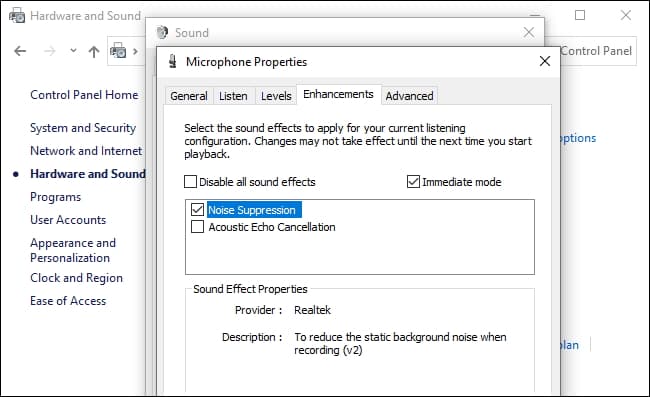
- #How to enable acoustic echo cancellation how to#
- #How to enable acoustic echo cancellation install#
- #How to enable acoustic echo cancellation full#
- #How to enable acoustic echo cancellation windows 10#
- #How to enable acoustic echo cancellation android#
Unplug out the USB device or other unessential peripheral devices from your computer, and then see if the microphone enhancement tab appears.
#How to enable acoustic echo cancellation install#
If you have only an integrated sound card on your computer, it is better to install a dedicated sound card, which often contains audio enhancement packages.Ĥ. Check if the sound card on your computer is right in the slot. Test if your device functions properly.ģ.
#How to enable acoustic echo cancellation windows 10#
You can also connect your microphone or headphones to other Windows 10 computers that are working regularly. Also, check your Bluetooth speakers, wireless speakers and more.Ģ. Make sure the device is intact (without problems in the cable or the button), and you can see the “Enhancement” tab in the Properties. Check the microphone or the headset with a microphone. Let's try some more troubleshooting steps:ġ. I'm sure you really want to resolve this as soon as possible. Public class AecContext extends fm.icelink.AecContext fm.icelink.No worries. For Android, they assume you are using the fm.icelink.android. NET, and the FM.IceLink.NAudio library as a fallback. The snippets assume you are using the FM.IceLink.Dmo library in. Note that due to the platform limitations mentioned above, there are only code snippets for C# and Android. This processor uses DirectX Media Objects and will generally provide better echo cancellation. NET, if supported, you can simply provide an instance of FM.
#How to enable acoustic echo cancellation how to#
The code below demonstrates how to calculate this for each platform. Generally, you want this to be the combined delay between the sender and receiver. The tail length tells the library how long to keep track of audio data for echo cancellation. Its constructor requires you to specify two things: the audio settings and the tail length to use for echo cancellation. For this, you should create and return an instance of FM.

The next method you must implement is CreateProcessor. In your implementation, instantiate a sink appropriate for your platform, as shown in the examples below. Generally, this will correspond to your system speakers. This method creates a sink where the mixed audio output can be played. You must first implement the CreateOutputMixerSink method. There are two methods to implement, CreateOutputMixerSink and CreateProcessor. You will need to implement a platform-specific version of this for each of your projects. The FM.IceLink.AecContext class is an abstract class that provides baseline acoustic echo cancellation functionality. Instead, include the shared object library that can be found in the Xamarin/Libraries/Android/lib/arm64-v8a, Xamarin/Libraries/Android/lib/armebi-v7a and Xamarin/Libraries/Android/lib/x86 folders.
#How to enable acoustic echo cancellation android#
You will need to include FM., and the architecture-specific build for the libaudioprocessingfm.dll native library. Do not include the Android JNIs. If you are working with proguard you will also need to specify the following proguard rule: -keep public class fm.dioprocessing.** For a Xamarin Android Project You will need to include fm. , and the architecture-specific build for the libaudioprocessingfmJNI.so native library. This can be found in the Android/Libraries/jniLibs/arm64-v8a, Android/Libraries/jniLibs/armebi-v7a and Android/Libraries/jniLibs/x86 folders. NET version, ie: DotNet20, DotNet35, etc.

This can be found in the NET/DotNetXX/Libraries/lib/win_x86 and NET/DotNetXX/Libraries/lib/win_圆4 folders of the standard IceLink distribution, where XX is the. You will need to include FM., and the architecture-specific build for the libaudioprocessingfm.dll native library. Similarly, this is not needed on web platforms as each browser has its own implementation.

There are no libraries for iOS and macOS because Apple implements their own echo cancellation so there is no need for IceLink to re-invent the wheel.

#How to enable acoustic echo cancellation full#
Here we cover the inclusion of the audio processing libraries specifically, full instructions on setting up project structure are covered in the Starting a New Project section. The acoustic echo cancellation implementation can be found in the FM.IceLink.AudioProcessing library and associated native libraries. Read on for information on how to add this to your projects. It is included with the standard IceLink distribution as a separate library. IceLink provides an acoustic echo cancellation implementation. If someone retransmits data that is similar enough to the data you have just sent, it is recognized as an echo and is removed from the audio data before playback. Acoustic Echo Cancellation solves this by keeping track of the audio data you send. The remote peer is playing your audio stream through the speakers, then picking it up with the microphone and streaming it back to you. If you ever hear yourself speaking a few hundred milliseconds after you have spoken, this is most likely because the remote peer does not have Acoustic Echo Cancellation (AEC).


 0 kommentar(er)
0 kommentar(er)
